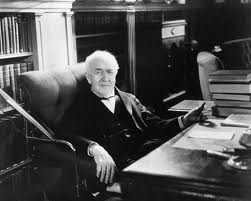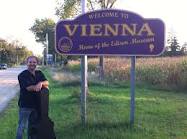 Six kilometers above the northeastern shore of Lake Erie, the sleepy hamlet of Vienna, Ont. boasts a strong but little-known connection with the family of Thomas Alva Edison (1847-1931), the legendary American inventor, who might have been born on Canadian soil but for a quirk of history and fate.
Six kilometers above the northeastern shore of Lake Erie, the sleepy hamlet of Vienna, Ont. boasts a strong but little-known connection with the family of Thomas Alva Edison (1847-1931), the legendary American inventor, who might have been born on Canadian soil but for a quirk of history and fate.
Four generations of Edisons lived in Vienna, including Thomas Alva’s parents, Nancy and Samuel Edison, Jr. As a child, he spent many summers here, visiting his grandfather. Some 40 Edison family members are buried in local cemeteries and, until recent decades, numerous cousins lived in the vicinity.
The Leonardo da Vinci of the electrical age, Edison filed 1,024 patents in his 84 years. His inventions include the lightbulb, the phonograph, the electric battery, the automotive sparkplug, the movie camera, and sprocketed movie film.
Occupying a pleasing, two-storey 1853 farmhouse in Vienna, the Edison Museum offers many intriguing antiques, artifacts, devices and displays relating to the career and local affiliation of its immensely creative namesake.
The rooms on the main floor contain period furniture donated by local families, including some pieces once owned by the Edisons. For example, an antique clock on the mantle was an anniversary gift that the inventor’s grandfather, Captain Samuel Edison, Sr., purchased for his wife, the former Nancy Simpson, on a visit to New York. The walls and tables are adorned with a few good photographs of the inventor and some of his ancestors.
 Several rooms upstairs display phonographs and other Edison devices. Cindy Franklin, an occasional guide, winds the crank of an Edison-brand phonograph machine and slides the needle onto the nearly imperceptible grooves of an Edison-brand bakelite cylinder. Instantly, rhythmic 1920s-style band music pours from the megahorn, its syncopation filling the air like a genie that has been freed from a bottle.
Several rooms upstairs display phonographs and other Edison devices. Cindy Franklin, an occasional guide, winds the crank of an Edison-brand phonograph machine and slides the needle onto the nearly imperceptible grooves of an Edison-brand bakelite cylinder. Instantly, rhythmic 1920s-style band music pours from the megahorn, its syncopation filling the air like a genie that has been freed from a bottle.
Next she turns the switch on an original electric lightbulb which also dates from the early 20th century. It instantly glows with light. “The filament,” she says, “is in excellent condition. It was made of bamboo.”
Display cases hold numerous odd-shaped bulbs, batteries, phonograph needles, and old books about Edison, including one written by his friend and colleague, Henry Ford. There is also an array of sparkplugs. After Edison designed this automotive necessity, an ex-employee allegedly stole his design and established the company that is perhaps the best-known manufacturer of sparkplugs today.
An upstairs bedroom, styled as a Ladies’ Sewing Room, is supposedly haunted. One evening, a board meeting in the parlour was interrupted by “a lot of noises, like scraping and bumping” coming from above, Franklin relates. The board never returned at night — and the tale became part of the house’s well-treasured lore.
The Edison family’s connection to Vienna begins with Thomas Alva’s earliest known ancestor, John Edison, his great-grandfather. Ironically, it was John Edison’s loyalty to the British Crown that first brought him into Canadian territory, just as, three generations later, it was lack of loyalty to the British that forced Thomas Alva’s father to leave.
A United Empire loyalist, John Edison fled the United States after the Revolutionary War, settling with his family in Digby, N.S., in the 1780s. In 1811, already an old man, he trailblazed into the then-largely unsettled area above Lake Erie known as the Talbot Settlement, accompanied by several of his married children and their families.
Thomas Alva’s grandfather, Samuel Edison, Sr., became a captain in the War of 1812 and was later given the honour of naming the town: no one knows why he chose Vienna. Thomas Alva’s father, Samuel Edison, Jr., had been an outspoken supporter of William Lyon Mackenzie’s failed rebellion of 1837, and was forced to flee, as Mackenzie had done, in fear for his life. Crossing the icy St. Clair River at Sarnia, he later sent for his family. They settled in Milan, Ohio, where Thomas Alva was born in 1847.
The decade in which the boy spent summers with his grandfather in Vienna was reportedly the grandest the town would ever know. In the 1850s, at the height of the lumber boom, Vienna boasted a population that is estimated as high as 5,000, or roughly ten times its present 500. Loggers would float great harvests of oak and red pine down the Otter Creek to Port Burwell, where the lumber was loaded onto ships bound for England, Europe and the West Indies, passing through the Welland and Erie canals on their way to the Atlantic.
Unfortunately, once the region’s trees were gone, the topsoil quickly disappeared as well, blighting the sandy landscape for roughly half a century. The advent of tobacco farming in the 1920s ended the area’s long economic depression.
Only a few historic buildings in town have survived the ravages of flood and fire. They include the United Church, the Anglican Church and the the Library, a former town hall dating from 1862. Incredibly, the town may boast of another famous inventor: Frank A. Brownell, who developed the eponymous Brownie camera in partnership with George Eastman of Kodak fame.
By contrast, the nearby lakeside village of Port Burwell (population 1,000) retains at least a dozen good century homes and other structures. By far the most outstanding and picturesque is the Port Burwell Lighthouse, erected 1840 and presently the nation’s oldest wooden lighthouse. During certain hours, and upon payment of $1, visitors may climb to the top for a good view of the nearby beach, considered one of finest on the lake’s northern shore.
The Port Burwell Marine Museum is the crowded repository of many nautical souvenirs and models, including a reputedly very good collection of lighthouse lenses and markers, and a multitude of wheels, anchors, foghorns and other relics from various ships and shipwrecks. An antique typewriter, windvane, washtub, and other non-nautical items are also displayed, evidently for atmospheric purposes. The museum brings the rich seafaring history of the region to life.
The Township of Bayham, which includes Vienna, Port Burwell, Eden, Richmond and Straffordville, celebrates its 150th anniversary with a series of special events on Sat. July 22 and Sun. July 23. Highlights include a historic parade at 11:30 a.m. on Saturday, and a Happy Trails Country Hoe-down in late afternoon and evening on Saturday, both in Straffordville. Special events are planned for Vienna and Port Burwell as well.
Vienna is about 25 km south of Tillsonburg along Highway 19. The township’s website is www.bayham.on.ca. ♦
© 2004







